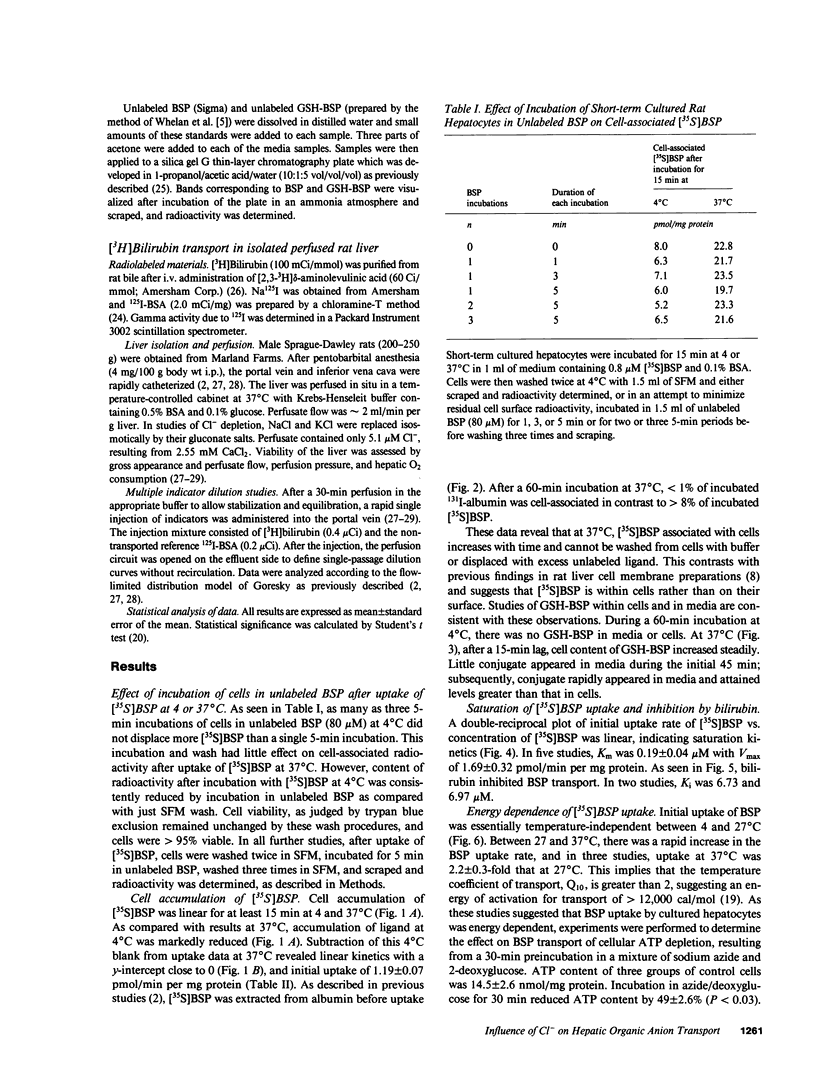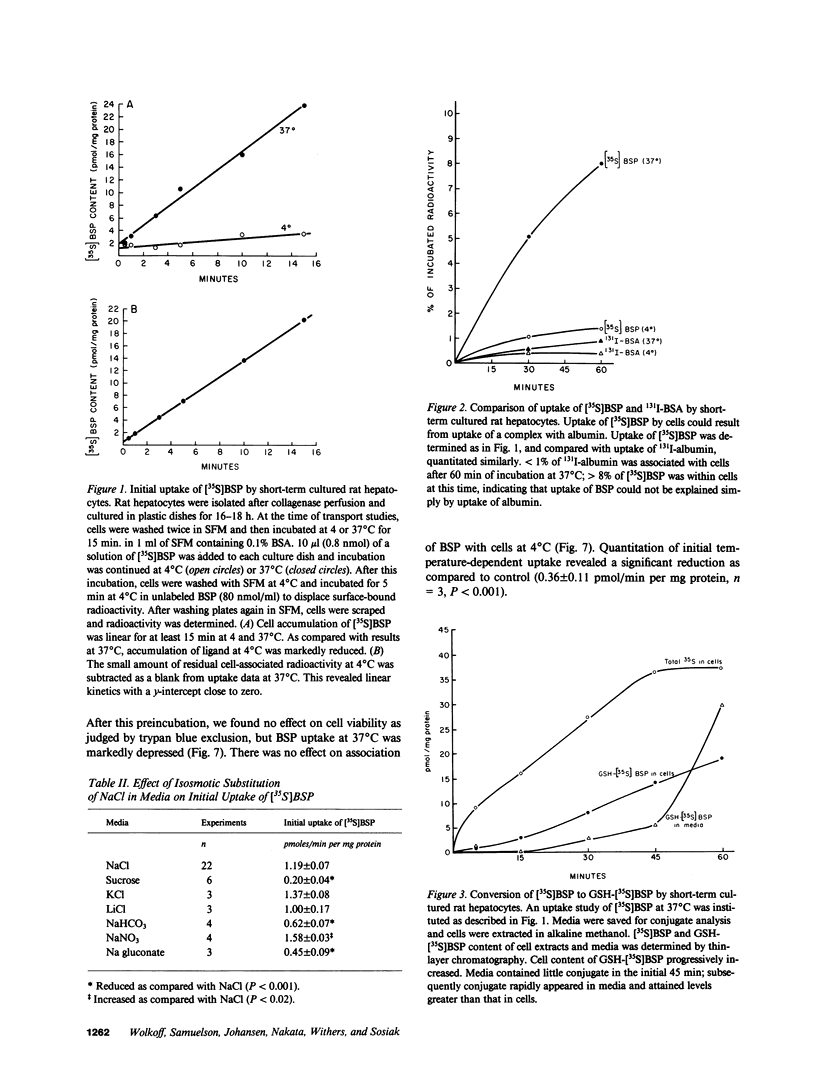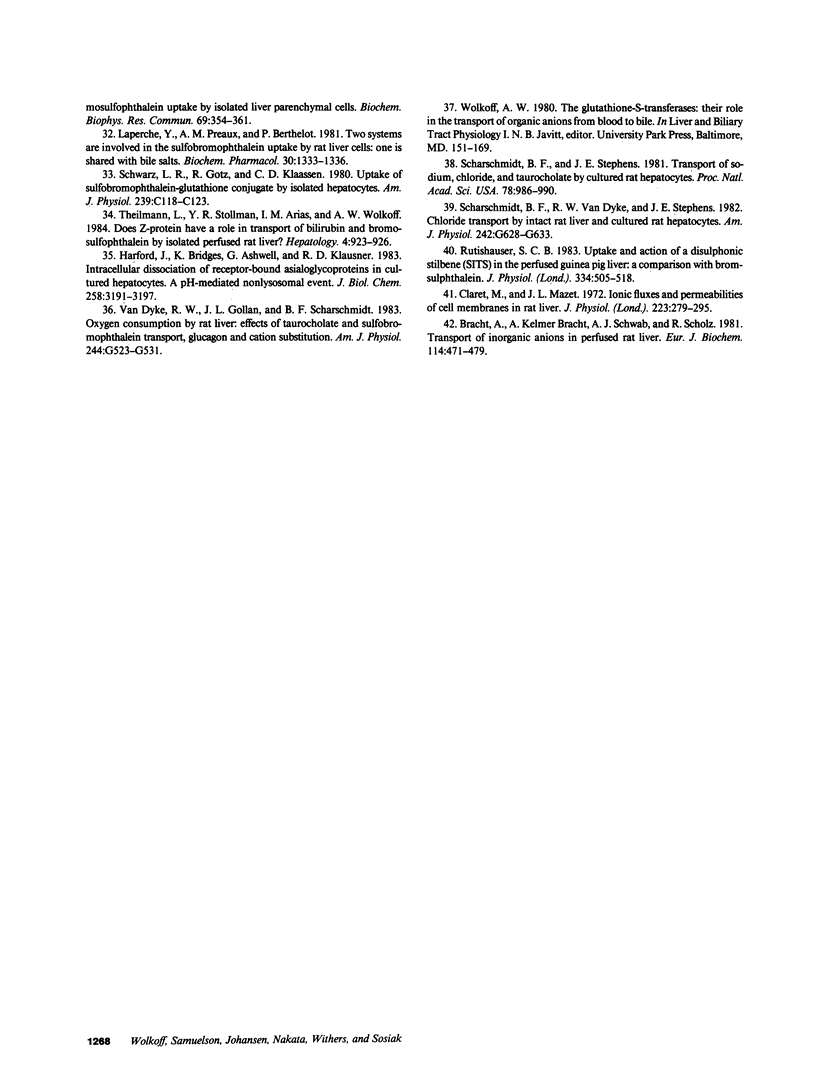Abstract
Transport of 35S-labeled sulfobromophthalein [35S]BSP was studied in short-term cultured rat hepatocytes incubated in bovine serum albumin. At 37 degrees C, initial uptake of [35S]BSP was 5-10-fold that at 4 degrees C, linear for at least 15 min, saturable, inhibited by bilirubin, and reduced by greater than 70% after ATP depletion or isosmotic substitution of sucrose for NaCl in medium. Replacement of Na+ by K+ or Li+ did not alter uptake, whereas replacement of Cl- by HCO-3 or gluconate- reduced uptake by approximately 40%. Substitution of Cl- by the more permeant NO-3 enhanced initial BSP uptake by 30%. Efflux of [35S]BSP from cells to media was inhibited by 40% after ATP depletion or sucrose substitution. To confirm these results in a more physiologic system, transport of [3H]bilirubin was studied in isolated livers perfused with control medium or medium in which Cl- was replaced by gluconate-. Perfusion data analyzed by the model of Goresky, revealed 40-50% reductions in influx and efflux with gluconate- substitution. These results are consistent with existence of a Cl-/organic anion-exchange mechanism similar to that described by others in renal tubules.
Full text
PDF









Selected References
These references are in PubMed. This may not be the complete list of references from this article.
- Bear C. E., Petrunka C. N., Strasberg S. M. Evidence for a channel for the electrogenic transport of chloride ion in the rat hepatocyte. Hepatology. 1985 May-Jun;5(3):383–391. doi: 10.1002/hep.1840050307. [DOI] [PubMed] [Google Scholar]
- Bracht A., Bracht A. K., Schwab A. J., Scholz R. Transport of inorganic anions in perfused rat liver. Eur J Biochem. 1981 Mar;114(3):471–479. doi: 10.1111/j.1432-1033.1981.tb05169.x. [DOI] [PubMed] [Google Scholar]
- Cabantchik Z. I., Rothstein A. Membrane proteins related to anion permeability of human red blood cells. I. Localization of disulfonic stilbene binding sites in proteins involved in permeation. J Membr Biol. 1974;15(3):207–226. doi: 10.1007/BF01870088. [DOI] [PubMed] [Google Scholar]
- Claret M., Mazet J. L. Ionic fluxes and permeabilities of cell membranes in rat liver. J Physiol. 1972 Jun;223(2):279–295. doi: 10.1113/jphysiol.1972.sp009847. [DOI] [PMC free article] [PubMed] [Google Scholar]
- Dhumeaux D., Berthelot P. Chronic hyperbilirubinemia associated with hepatic uptake and storage impairment. A new syndrome resembling that of the mutant Southdown sheep. Gastroenterology. 1975 Oct;69(4):988–993. [PubMed] [Google Scholar]
- GORESKY C. A. INITIAL DISTRIBUTION AND RATE OF UPTAKE OF SULFOBROMOPHTHALEIN IN THE LIVER. Am J Physiol. 1964 Jul;207:13–26. doi: 10.1152/ajplegacy.1964.207.1.13. [DOI] [PubMed] [Google Scholar]
- GREENWOOD F. C., HUNTER W. M., GLOVER J. S. THE PREPARATION OF I-131-LABELLED HUMAN GROWTH HORMONE OF HIGH SPECIFIC RADIOACTIVITY. Biochem J. 1963 Oct;89:114–123. doi: 10.1042/bj0890114. [DOI] [PMC free article] [PubMed] [Google Scholar]
- Habig W. H., Pabst M. J., Fleischner G., Gatmaitan Z., Arias I. M., Jakoby W. B. The identity of glutathione S-transferase B with ligandin, a major binding protein of liver. Proc Natl Acad Sci U S A. 1974 Oct;71(10):3879–3882. doi: 10.1073/pnas.71.10.3879. [DOI] [PMC free article] [PubMed] [Google Scholar]
- Harford J., Bridges K., Ashwell G., Klausner R. D. Intracellular dissociation of receptor-bound asialoglycoproteins in cultured hepatocytes. A pH-mediated nonlysosomal event. J Biol Chem. 1983 Mar 10;258(5):3191–3197. [PubMed] [Google Scholar]
- Harford J., Wolkoff A. W., Ashwell G., Klausner R. D. Monensin inhibits intracellular dissociation of asialoglycoproteins from their receptor. J Cell Biol. 1983 Jun;96(6):1824–1828. doi: 10.1083/jcb.96.6.1824. [DOI] [PMC free article] [PubMed] [Google Scholar]
- Howe R. B., Berk P. D., Bloomer J. R., Berlin N. I. Preparation and properties of specifically labeled radiochemically stable 3H-bilirubin. J Lab Clin Med. 1970 Mar;75(3):499–502. [PubMed] [Google Scholar]
- Kahn A. M., Aronson P. S. Urate transport via anion exchange in dog renal microvillus membrane vesicles. Am J Physiol. 1983 Jan;244(1):F56–F63. doi: 10.1152/ajprenal.1983.244.1.F56. [DOI] [PubMed] [Google Scholar]
- Kahn A. M., Branham S., Weinman E. J. Mechanism of urate and p-aminohippurate transport in rat renal microvillus membrane vesicles. Am J Physiol. 1983 Aug;245(2):F151–F158. doi: 10.1152/ajprenal.1983.245.2.F151. [DOI] [PubMed] [Google Scholar]
- Kahn A. M., Shelat H., Weinman E. J. Urate and p-aminohippurate transport in rat renal basolateral vesicles. Am J Physiol. 1985 Nov;249(5 Pt 2):F654–F661. doi: 10.1152/ajprenal.1985.249.5.F654. [DOI] [PubMed] [Google Scholar]
- LOWRY O. H., ROSEBROUGH N. J., FARR A. L., RANDALL R. J. Protein measurement with the Folin phenol reagent. J Biol Chem. 1951 Nov;193(1):265–275. [PubMed] [Google Scholar]
- Laperche Y., Preaux A. M., Berthelot P. Two systems are involved in the sulfobromophthalein uptake by rat liver cells: one is shared with bile salts. Biochem Pharmacol. 1981 Jun 1;30(11):1333–1336. doi: 10.1016/0006-2952(81)90317-8. [DOI] [PubMed] [Google Scholar]
- Levi A. J., Gatmaitan Z., Arias I. M. Two hepatic cytoplasmic protein fractions, Y and Z, and their possible role in the hepatic uptake of bilirubin, sulfobromophthalein, and other anions. J Clin Invest. 1969 Nov;48(11):2156–2167. doi: 10.1172/JCI106182. [DOI] [PMC free article] [PubMed] [Google Scholar]
- Lunazzi G., Tiribelli C., Gazzin B., Sottocasa G. Further studies on bilitranslocase, a plasma membrane protein involved in hepatic organic anion uptake. Biochim Biophys Acta. 1982 Feb 23;685(2):117–122. doi: 10.1016/0005-2736(82)90087-6. [DOI] [PubMed] [Google Scholar]
- Rutishauser S. C. Uptake and action of a disulphonic stilbene (SITS) in the perfused guinea-pig liver: a comparison with bromsulphthalein. J Physiol. 1983 Jan;334:505–518. doi: 10.1113/jphysiol.1983.sp014509. [DOI] [PMC free article] [PubMed] [Google Scholar]
- Scharschmidt B. F., Stephens J. E. Transport of sodium, chloride, and taurocholate by cultured rat hepatocytes. Proc Natl Acad Sci U S A. 1981 Feb;78(2):986–990. doi: 10.1073/pnas.78.2.986. [DOI] [PMC free article] [PubMed] [Google Scholar]
- Scharschmidt B. F., Van Dyke R. W., Stephens J. E. Chloride transport by intact rat liver and cultured rat hepatocytes. Am J Physiol. 1982 Jun;242(6):G628–G633. doi: 10.1152/ajpgi.1982.242.6.G628. [DOI] [PubMed] [Google Scholar]
- Scharschmidt B. F., Waggoner J. G., Berk P. D. Hepatic organic anion uptake in the rat. J Clin Invest. 1975 Nov;56(5):1280–1292. doi: 10.1172/JCI108204. [DOI] [PMC free article] [PubMed] [Google Scholar]
- Schwarz L. R., Götz R., Klaassen C. D. Uptake of sulfobromophthalein-glutathione conjugate by isolated hepatocytes. Am J Physiol. 1980 Sep;239(3):C118–C123. doi: 10.1152/ajpcell.1980.239.3.C118. [DOI] [PubMed] [Google Scholar]
- Stollman Y. R., Gärtner U., Theilmann L., Ohmi N., Wolkoff A. W. Hepatic bilirubin uptake in the isolated perfused rat liver is not facilitated by albumin binding. J Clin Invest. 1983 Aug;72(2):718–723. doi: 10.1172/JCI111021. [DOI] [PMC free article] [PubMed] [Google Scholar]
- Stollman Y. R., Theilmann L., Stockert R. J., Wolkoff A. W. Reduced transport of bilirubin and asialoorosomucoid in regenerating rat liver is a microtubule-independent event. Hepatology. 1985 Sep-Oct;5(5):798–804. doi: 10.1002/hep.1840050515. [DOI] [PubMed] [Google Scholar]
- Stremmel W., Gerber M. A., Glezerov V., Thung S. N., Kochwa S., Berk P. D. Physicochemical and immunohistological studies of a sulfobromophthalein- and bilirubin-binding protein from rat liver plasma membranes. J Clin Invest. 1983 Jun;71(6):1796–1805. doi: 10.1172/JCI110935. [DOI] [PMC free article] [PubMed] [Google Scholar]
- Theilmann L., Stollman Y. R., Arias I. M., Wolkoff A. W. Does Z-protein have a role in transport of bilirubin and bromosulfophthalein by isolated perfused rat liver? Hepatology. 1984 Sep-Oct;4(5):923–926. doi: 10.1002/hep.1840040523. [DOI] [PubMed] [Google Scholar]
- Uptake of bromosulfophthalein by isolated liver cells. Eur J Biochem. 1976 Apr 15;64(1):189–197. [PubMed] [Google Scholar]
- Weinberg S. L., Burckhardt G., Wilson F. A. Taurocholate transport by rat intestinal basolateral membrane vesicles. Evidence for the presence of an anion exchange transport system. J Clin Invest. 1986 Jul;78(1):44–50. doi: 10.1172/JCI112571. [DOI] [PMC free article] [PubMed] [Google Scholar]
- Weisiger R., Gollan J., Ockner R. Receptor for albumin on the liver cell surface may mediate uptake of fatty acids and other albumin-bound substances. Science. 1981 Mar 6;211(4486):1048–1051. doi: 10.1126/science.6258226. [DOI] [PubMed] [Google Scholar]
- Whelan G., Hoch J., Combes B. A direct assessment of the importance of conjugation for biliary transport of sulfobromophthalein sodium. J Lab Clin Med. 1970 Apr;75(4):542–557. [PubMed] [Google Scholar]
- Wolkoff A. W., Chung C. T. Identification, purification, and partial characterization of an organic anion binding protein from rat liver cell plasma membrane. J Clin Invest. 1980 May;65(5):1152–1161. doi: 10.1172/JCI109770. [DOI] [PMC free article] [PubMed] [Google Scholar]
- Wolkoff A. W., Goresky C. A., Sellin J., Gatmaitan Z., Arias I. M. Role of ligandin in transfer of bilirubin from plasma into liver. Am J Physiol. 1979 Jun;236(6):E638–E648. doi: 10.1152/ajpendo.1979.236.6.E638. [DOI] [PubMed] [Google Scholar]
- Wolkoff A. W., Ketley J. N., Waggoner J. G., Berk P. D., Jakoby W. B. Hepatic accumulation and intracellular binding of conjugated bilirubin. J Clin Invest. 1978 Jan;61(1):142–149. doi: 10.1172/JCI108912. [DOI] [PMC free article] [PubMed] [Google Scholar]
- Wolkoff A. W., Klausner R. D., Ashwell G., Harford J. Intracellular segregation of asialoglycoproteins and their receptor: a prelysosomal event subsequent to dissociation of the ligand-receptor complex. J Cell Biol. 1984 Feb;98(2):375–381. doi: 10.1083/jcb.98.2.375. [DOI] [PMC free article] [PubMed] [Google Scholar]
- Wolkoff A. W., Sosiak A., Greenblatt H. C., Van Renswoude J., Stockert R. J. Immunological studies of an organic anion-binding protein isolated from rat liver cell plasma membrane. J Clin Invest. 1985 Aug;76(2):454–459. doi: 10.1172/JCI111993. [DOI] [PMC free article] [PubMed] [Google Scholar]
- van Bezooijen C. F., Grell T., Knook D. L. Bromsulfophthalein uptake by isolated liver parenchymal cells. Biochem Biophys Res Commun. 1976 Mar 22;69(2):354–361. doi: 10.1016/0006-291x(76)90529-5. [DOI] [PubMed] [Google Scholar]
- van Dyke R. W., Gollan J. L., Scharschmidt B. F. Oxygen consumption by rat liver: effects of taurocholate and sulfobromophthalein transport, glucagon, and cation substitution. Am J Physiol. 1983 May;244(5):G523–G531. doi: 10.1152/ajpgi.1983.244.5.G523. [DOI] [PubMed] [Google Scholar]


